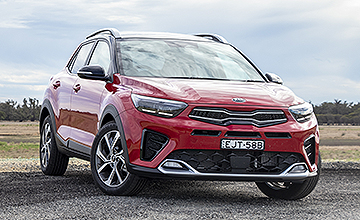Make / Model Search
OptionsCar reviews - Kia - Stonic - GT-LineKia modelsOur OpinionWe like Styling, torquey engine, handling, comfortable, build quality, ergonomics. Room for improvement Lacklustre dual-clutch transmission, lack of rear amenities, compromised cargo space. It’s taken a while, but the new Kia Stonic is finally here and we’ve had a go.27 Jul 2021 Overview
BASED on the Rio, the Stonic is Kia’s take on a jacked-up city car designed to make the most of the ongoing SUV craze sweeping not only across Australia, but the rest of the world too.
Slotting in below the Seltos, the Stonic shares its underpinnings and drivetrains with the Rio but throws in a loftier ride height, slightly bigger dimensions all round and some tougher, more rugged SUV styling cues.
On that last note, we think the Stonic looks great; different enough to the Rio that they won’t be confused for one another but still with some clear family resemblance.
Priced from $22,990 driveaway, Kia Australia is offering five Stonic variants across three trim levels, with the range topping out at $29,990 for the flagship GT-Line.
To find out if the brand’s latest high-riding hatch is a worthy competitor within its segment, we spent some time putting the flagship GT-Line through its paces both in town and on the open road.
Drive Impressions
Stepping into the Stonic GT-Line for the first time, we were initially struck by the cabin’s familiarity. It’s almost a carbon copy of the Rio GT-Line’s but then again, that’s hardly surprising given they’re essentially the same car.
Everything is laid out logically and neatly with all the buttons easy to find and of a decent size, making it more likely that you’ll hit your intended switch while driving.
Being the GT-Line, the cabin scores some fake carbon-fibre effect trim across the dash, a flat-bottomed steering wheel, GT-Line embossed seats and some sports pedals to help spice things up a bit.
From behind the wheel, all controls and materials have a solid feel to them, with the seats themselves being decently comfortable, although those with longer legs may find the pedal box a bit cramped.
The 8.0-inch infotainment display looks great and is easy to use while the analogue instrument cluster is straight forward and fuss-free.
As usual for this class of vehicle, things aren’t so good in the back. Space in every direction is at a premium for anyone approaching six feet tall, coupled with the lack of air vents, centre armrest or cupholders for rear occupants.
Cargo space behind the second row is a very competitive 352 litres, though a good deal of that volume comes from the boot’s low floor, resulting in noticeably higher load lip compared to some of its key rivals.
In classic hatch/SUV fashion, the second row is stowable but those hoping for a flat load space will be disappointed as the boot floor sits substantially lower than the folded rear seats.
Propulsion in the GT-Line comes exclusively from a turbocharged 1.0-litre three-cylinder petrol engine developing 74kW of power and 172Nm of torque – the rest of the range makes do with a 74kW/133Nm naturally aspirated 1.4-litre four-banger – all of which is sent to the front wheels via a seven-speed dual-clutch automatic transmission.
In isolation, the force-fed little triple is a solid performer with a surprisingly meaty mid-range, so much so we regularly took to upshifting early with the manual override when accelerating up to highway speeds to keep the revs in the middle of the torque band rather than letting it rev out.
If you do let the needle run, you’ll be rewarded with a half-decent engine note and find the engine never becomes thrashy, showing decent levels of refinement both in town and on the open road. For a three-cylinder, it is surprisingly smooth and quiet.
The same can’t be said, however, about the seven-speed DCT that ultimately proves to be the Stonic GT-Line’s biggest weakness.
Compared to the likeable engine, the transmission is simply sub-par around town as it seems to trip over itself when moving away from a standstill – especially when cold or in Eco mode – and shudders when trying to execute low-speed manoeuvres such as parking.
Things improve out on the open road, where it just gets on with the job and lets the engine utilise its torque without changing down, but the shifts are no faster or more intuitive than those of a modern torque converter.
Looking past the lacklustre transmission, we have no complaints with the GT-Line’s underpinnings which, surprise surprise, are the same as the Rio GT-Line’s, albeit with some extra ride height.
Being the GT-Line and befitting its sportier body kit and engine, the flagship Stonic rides on a slightly firmer suspension tune than the rest of the range, which combines well with its low kerb weight to create a solid and agile-feeling package.
As we’ve come to expect from Kia, irregular road surfaces, mid-corner bumps and camber changes are all met with an impressive level of composure and while the low-speed ride around town is on the firmer end of the spectrum, it’s never uncomfortable.
We’d stop short of calling the ride and handling decidedly sporty – the Ford Puma ST-Line easily takes top honours in this segment – but there is still enough athletic ability on hand to have the occasional bit of fun through the bends.
Overall noise, vibration and harshness (NVH) levels both in town and on the open road are good, as is the fuel economy.
Kia quotes a combined consumption figure of 5.7L/100km for the GT-Line, a figure we nearly matched after a week of testing with the trip computer displaying a figure of 5.9L/100km.
Visibility around town is par for the course for this class of car, with the usual blind spot being created by the oversized C-pillar.
That last point largely sums up the Stonic GT-Line; par for the course.
Based on an already solid city car, the Stonic GT-Line is a stylish, well-built and practical light SUV that, for the most part, drives well and gets on the job.
Save for its seven-year/unlimited kilometre warranty though, we’re not sure there’s anything that makes it stand out against the rest of the stylish, well-built and practical light SUVs available on the market.
Unless you desperately need the extra ground clearance, we’d recommend buying a Cerato Sport or Sport+ over the Stonic GT-Line given they offer more space, more standard equipment, more power and a better transmission for roughly the same money.  All car reviews Alfa Romeo Alfa Romeo Abarth Abarth Alpine Alpine Alpina Alpina Audi Audi Aston Martin Aston Martin BMW BMW Bentley Bentley Chevrolet Chevrolet Chery Chery Citroen Citroen Chrysler Chrysler Dodge Dodge Cupra Cupra Ferrari Ferrari DS DS Ford Ford Fiat Fiat FPV FPV Foton Foton GWM GWM Great Wall Great Wall Holden Holden Haval Haval HSV HSV Honda Honda Hyundai Hyundai Hummer Hummer Isuzu Isuzu Infiniti Infiniti Jeep Jeep Jaguar Jaguar Lamborghini Lamborghini Kia Kia LDV LDV Land Rover Land Rover Lotus Lotus Lexus Lexus Maserati Maserati Mahindra Mahindra McLaren McLaren Mazda Mazda Mercedes-Benz Mercedes-Benz Mercedes-AMG Mercedes-AMG Mini Mini MG MG Nissan Nissan Mitsubishi Mitsubishi Peugeot Peugeot Opel Opel Proton Proton Porsche Porsche Renault Renault Ram Ram Rover Rover Rolls-Royce Rolls-Royce Skoda Skoda Saab Saab SsangYong SsangYong Smart Smart Suzuki Suzuki Subaru Subaru Toyota Toyota Tesla Tesla Volvo Volvo |
OptionsClick to share
|









Facebook Twitter Instagram